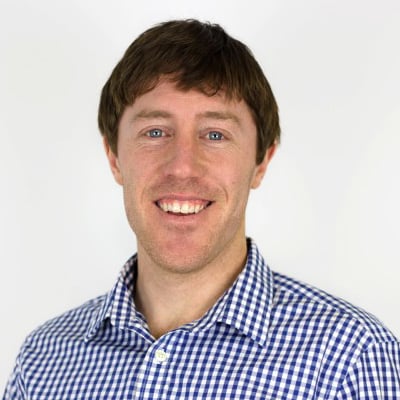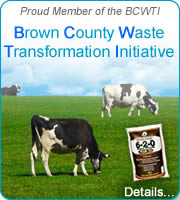Bay Business Journal Vol 17 #3 (June / July 2009)
View / Download the article as a PDF
Humans do it, animals do it, factories do it. Even cells do it.
Producing waste is just one of those unavoidable evils – right up there with facing our mortality and being accountable to the Internal Revenue Service. But what happens to all the waste we and our fellow biological beings produce, and – no pun intended — where do we go with it?
The Brown County Waste Transformation Initiative (BCWTI) has come up with a possible answer: Process it and sell it around the world as nutrient-rich, pathogen-free fertilizer nuggets.
“It’s a win-win for everyone involved,” says Brown County Executive Tom Hinz. “We will be cleaning up the environment and generating a product that can be sold on the market, while creating jobs at the same time. It’s a situation you don’t see all that frequently.”
The BCWTI, a project led and supported by county and private enterprise, is slated to “take waste and turn it into an asset, pelletizing it and shipping it out to other places in the world that need nutrients,” says Jayme Sellen, legislative assistant for Hinz.
Not reinventing the wheel Making fertilizer out of waste is nothing novel for a local company involved in the BCWTI. FEECO International – short for Fertilizer Engineering and Equipment Company – already does this on a bigger scale. The 58-yearold company builds equipment, systems and facilities around the world that make fertilizer pellets out of animal waste.
Because it’s 90 percent water, shipping the raw material is impractical. So it makes sense to dry it out first, which FEECO does. “The heart of the system is a paddle mixer and a rotary dryer,” says FEECO International Vice President and General Manager Lee Hoffmann.
One of FEECO International’s current projects in Australia is for a Japanese firm that owns a 250,000-animal beef-farming operation. The waste transformation plant FEECO International is building there will produce 100,000 metric tons of pellet fertilizer per year, Hoffmann says.
Compared to that waste situation, Brown County’s manure production pales. “The challenge we have in Brown County is that we have (farm manure) waste, but not enough to build a (waste transformation) plant,” Hoffmann says.
That’s precisely why the project is called waste transformation instead of manure transformation. It uses waste from the metropolitan sewerage districts and slaughterhouses in addition to manure.
The waste for the local project would come from:
· Two Green Bay beef processing plants – each of which emit three kinds of waste (barn manure, paunch or undigested food from the slaughtered animals’ stomachs, and liquid); and
· Biosolids from two metropolitan sewer systems – Green Bay and De Pere.
· Manure from dairy and cattle operations.
Partners in the BCWTI project development include FEECO International; ENCAP; Sanimax; American Foods Group; JBS Packerland (formerly Smithfield Beef); Daanen & Janssen, Inc., Ag Ventures, LLC; Brown County Land & Conservation Department; Green Bay Area Chamber of Commerce; Green Bay Metropolitan Sewerage District; and the De Pere Wastewater Treatment Plant.
But FEECO International isn’t creating the world from dust in seven days. It’s following a similar business model it did when it formed the offshoot company ENCAP, says Hoffmann.
ENCAP takes unrecyclable waste from the paper industry – pulps and fibers that have been recycled so many times that they can’t be made into paper again – and creates a wide variety of garden products by encapsulating it with seeds, lime, gypsum and other ingredients in a way that minimizes runoff, Hoffmann says. Its products are sold nationwide.
Where is the manure coming from?
The issue of animal waste and what to do with it worked out better in our grandparents’ day, when farms were smaller, with fewer animals and more land, and there were more of them. Each farm could use its own animals’ manure for its own crops.
But that model didn’t prove profitable enough in an era of global trading and stiff competition. Many farmers either got out of farming or expanded into large farms – some with hundreds or thousands of animals and less land. These farms are known by many names – confined- animal feeding operations (CAFOs), mega-farms, factory farms to name a few – but the upshot is the same as far as the environment is concerned.
“The bottom line is we are running out of farm land and ways to take care of this waste and we can’t afford to lose our packing plants,” Hinz says. “If anything, we need to increase production at the packing plants.”
Between 1991 and 2001, Brown County’s cattle population grew by 6,900. During the same period of time, its total farmland area shrunk by 22,000 harvestable acres, according to Brad Holtz, agronomist with the Brown County Land and Water Conservation Department.
Cows produce 18 times the waste of humans. That means a 1,000-animal megafarm yields as much waste as the municipal sewer for a city the population of De Pere and that the nearly 7,000 cattle adds to the county’s cattle population between 1991 and 2001 adds waste the equivalent of a metro area with almost 126,000 people.
That’s a lot of waste to process, and it doesn’t include the amount of industrial waste produced from slaughterhouses.
Holtz cites a recent marketing survey of 50 Wisconsin farmers that identified waste as a roadblock to their expansion. “From smallest to largest they all says pretty much unanimously that the biggest problem was what they called a manure bottleneck,” Holtz says. “If the status quo is maintained, they will be hauling their manure farther, which is expensive, or face the challenges of managing the waste stream from that base.”
So why can’t we spread it on our fields?
Crops can only absorb so much fertilizer and nutrients before they’re saturated. Too many nutrients can be as bad as not enough, says Holtz.
Like the human body processing vitamins and minerals, the earth rejects an excess of certain nutrients. For humans, too much of a water-soluble vitamin such as Vitamin C gets excreted through urine. Too much of a fat-soluble vitamin, such as Vitamin A, D or E, gets stored in the fat and liver and can become toxic if there’s too much of it.
The earth is similar to the human body in this way. “When we apply more nutrients to the plants than the plants can utilize, it attaches itself to the sediment, and when the sediment leaves the fields, it gets into the surface water and causes problems,” Holtz says.
The No. 1 problem nutrient for our area is too much phosphorous, Holtz adds. Although phosphorous is a natural nutrient that occurs in soil, it’s a trace mineral, which means most living things need only a tiny amount of the stuff. Most of the phosphorous found in soil is in a fixed form, which means it’s not available for plant use, Holtz says. So when phosphorous is applied to crops via manure or bone meal, runoff of phosphorous happens.
“We know from years and years of studies in other counties and in Northeast Wisconsin is that one of the issues is that phosphorous can get in the surface water,” says Holtz.
Surface water includes rivers, streams and lakes. It gets contaminated when runoff from farm land, roads and lawns flows into the storm sewers and ultimately into the surface water. “Once it gets into the water, it causes algae blooms,” Holtz says Algae blooms compete with fish and other plants for oxygen in the water and end up killing fish and other marine life and causing smelly, green water.
So how much too much phosphorous does Brown County produce? Holtz says that, based on “back-of-the-envelope calculations,” Brown County produces 194,000 more pounds of phosphorous per year than the area can possibly use.
Brick and mortar facility?
The initiative landed the BCWTI a $30,000 grant from the University of Wisconsin Systems Solid Waste Research Council for field trials. FEECO International made 6,000 tons of fertilizer pellets in mid-April as a trial using the combined sources of waste, Hoffmann says.
The trial is underway on three plots of land in Brown County, Holtz says. They’ll be testing and monitoring the land closely.
If all goes as expected – and there’s an 80 percent chance it will, says Hoffmann – the BCWTI could result in a plant that would serve as the official waste transformation plant for the area. It would produce around 17,000 tons of fertilizer, Hoffmann says.
Hoffmann says the plant – estimated initially at around $5 million to build – would employ between 15 and 20 people. He’s mum on potential locations, though, and says who would actually own such a plant is still being mulled over. “We are still investigating the best structure for ownership,” Hoffmann says.
FEECO has agreed to build the waste transformation plant, should it come to fruition, he says.
So far, three of the stakeholders – ENCAP, Daanen & Janssen and AgVentures—have indicated a desire to take the transformed fertilizer product to market, Hoffmann says.
He adds that they’re still trying to gauge which of the waste-producing stakeholders would want to own or run such a plant.
Meanwhile, Hinz is eager to see the plan go forward. Having the BCWTI in place would allow dairies and cattle operations to expand, he says, because it would answer the question of what to do with all of the waste. “From a dairy standpoint, it would allow better compatibility, to allow cows and humans to live together,” Hinz says.
###


